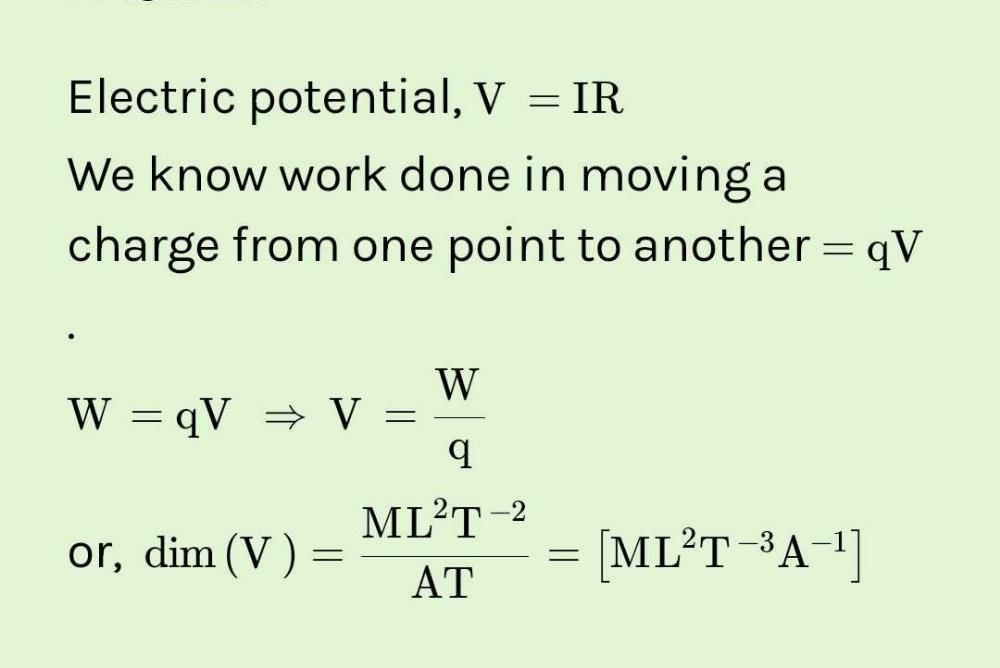Class 12 Exam > Class 12 Questions > Dimension formula of potential difference?
Start Learning for Free
Dimension formula of potential difference?
Most Upvoted Answer
Dimension formula of potential difference?
The dimension formula of potential difference is a physical quantity that represents the amount of work done per unit charge in moving a charge from one point to another point in an electric field. In other words, it is the difference in electric potential energy per unit charge between two points in an electric circuit. The dimension formula of potential difference is expressed in the SI unit of volts (V).
Formula for Potential Difference
The formula for potential difference is given by:
V = W/q
where V is the potential difference, W is the work done, and q is the charge. The potential difference is measured in volts (V), work done is measured in joules (J), and charge is measured in coulombs (C).
Dimensional Formula for Potential Difference
The dimensional formula for potential difference can be derived by substituting the dimensions of work and charge in the formula for potential difference. The dimension formula for work is given by:
[W] = [M][L]^2[T]^-2
where M represents mass, L represents length, and T represents time.
The dimension formula for charge is given by:
[q] = [I][T]
where I represents electric current and T represents time.
Substituting these dimension formulas in the formula for potential difference, we get:
[V] = [W]/[q]
[V] = [M][L]^2[T]^-2/[I][T]
[V] = [M][L]^2[T]^-3[I]^-1
Therefore, the dimension formula for potential difference is:
[V] = [M][L]^2[T]^-3[I]^-1
Conclusion
The dimension formula of potential difference represents the physical quantity that measures the amount of work done per unit charge in moving a charge from one point to another point in an electric field. The potential difference is measured in volts (V), and its dimensional formula is expressed in terms of mass, length, time, and electric current. Understanding the dimension formula of potential difference is essential in the study of electrical circuits and their applications.
Formula for Potential Difference
The formula for potential difference is given by:
V = W/q
where V is the potential difference, W is the work done, and q is the charge. The potential difference is measured in volts (V), work done is measured in joules (J), and charge is measured in coulombs (C).
Dimensional Formula for Potential Difference
The dimensional formula for potential difference can be derived by substituting the dimensions of work and charge in the formula for potential difference. The dimension formula for work is given by:
[W] = [M][L]^2[T]^-2
where M represents mass, L represents length, and T represents time.
The dimension formula for charge is given by:
[q] = [I][T]
where I represents electric current and T represents time.
Substituting these dimension formulas in the formula for potential difference, we get:
[V] = [W]/[q]
[V] = [M][L]^2[T]^-2/[I][T]
[V] = [M][L]^2[T]^-3[I]^-1
Therefore, the dimension formula for potential difference is:
[V] = [M][L]^2[T]^-3[I]^-1
Conclusion
The dimension formula of potential difference represents the physical quantity that measures the amount of work done per unit charge in moving a charge from one point to another point in an electric field. The potential difference is measured in volts (V), and its dimensional formula is expressed in terms of mass, length, time, and electric current. Understanding the dimension formula of potential difference is essential in the study of electrical circuits and their applications.

|
Explore Courses for Class 12 exam
|

|
Similar Class 12 Doubts
Dimension formula of potential difference?
Question Description
Dimension formula of potential difference? for Class 12 2024 is part of Class 12 preparation. The Question and answers have been prepared according to the Class 12 exam syllabus. Information about Dimension formula of potential difference? covers all topics & solutions for Class 12 2024 Exam. Find important definitions, questions, meanings, examples, exercises and tests below for Dimension formula of potential difference?.
Dimension formula of potential difference? for Class 12 2024 is part of Class 12 preparation. The Question and answers have been prepared according to the Class 12 exam syllabus. Information about Dimension formula of potential difference? covers all topics & solutions for Class 12 2024 Exam. Find important definitions, questions, meanings, examples, exercises and tests below for Dimension formula of potential difference?.
Solutions for Dimension formula of potential difference? in English & in Hindi are available as part of our courses for Class 12.
Download more important topics, notes, lectures and mock test series for Class 12 Exam by signing up for free.
Here you can find the meaning of Dimension formula of potential difference? defined & explained in the simplest way possible. Besides giving the explanation of
Dimension formula of potential difference?, a detailed solution for Dimension formula of potential difference? has been provided alongside types of Dimension formula of potential difference? theory, EduRev gives you an
ample number of questions to practice Dimension formula of potential difference? tests, examples and also practice Class 12 tests.

|
Explore Courses for Class 12 exam
|

|
Signup for Free!
Signup to see your scores go up within 7 days! Learn & Practice with 1000+ FREE Notes, Videos & Tests.




















